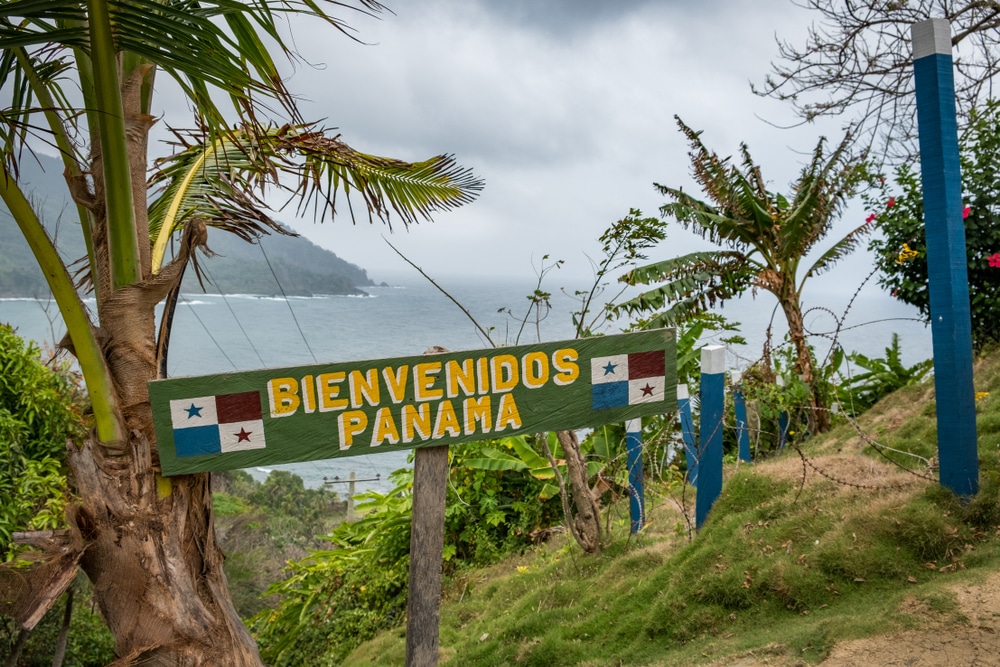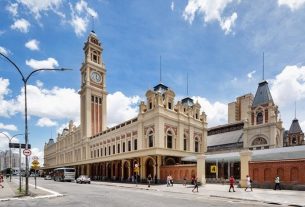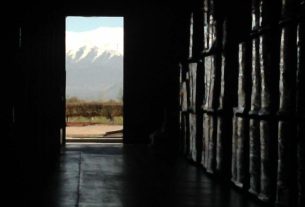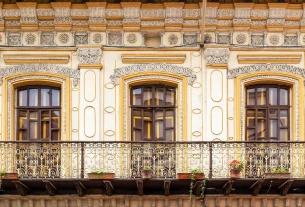A small isthmus that connects North and South America, Central America may seem small on the map, but it is a giant in terms of its culture, nature and history. Filled with postcard beaches, active and dormant volcanoes, ruins of pre-Columbian civilizations and a diversity of peoples of envy, the place attracts tourists from all over the world who take the distance to cross the borders of Central America by land.
Many of them take advantage of the geographical distance to travel the countries of the region of one shot. Others are in the midst of a larger crossing, often on a dream trip across the American continent. Whatever the case, I prepared a guide on how to travel through Central America by land and cross borders of Panama, Costa Rica, Nicaragua, Honduras, El Salvador, Guatemela and Belize without having to break my head much.
How to cross the borders of Central America by land?
Even if on the map the distance between point A and point B do not look so great, the time it takes you to cross it can equal to going from São Paulo to Recife or some other giant trip in Brazil. That’s because this little piece of land we call Central America is extremely mountainous and the roads full of curves, which increases the distances in a straight line by many kilometers.
Not to mention social and political issues that can affect travel. With unstable and often inefficient governments, you can face bad roads, blockades and strikes. Of course, Central America itself is not a homogeneous block and there are well-marked regional contrasts even in such a small territory when compared, for example, to South America. This means that there are parts there where you will feel in Miami and others in which you will take a shock from Latin America. Whether this can happen even within a country, let alone as you cross borders.
I, who do not drive, can not help with many tips for those who will make the car ride, although the information about borders below and other general tips are useful for everyone. But if you are going to take the trip using public transport, the Tica Bus company makes routes all over Central America and has interesting options of tickets, in which you can buy a longer stretch and stop for a few days along the way before following travel.
For example, they do not make the direct trip between Panama City and Managua, but they do sell tickets with this route. Thus, you “win” a mandatory stop in San José, Costa Rica, where you would need to change buses. Only you do not necessarily have to take the second bus on the same day, you can spend a few days there before heading to Nicaragua. This is a good way to get to know Central America if you can schedule these dates in advance (and understand the routes offered on their website, which can be somewhat confusing).
Penas Blancas, one of the borders of Central America, between Nicaragua and Costa Rica. Photo by Wollertz, Shutterstock
Tica is not the only company that circulates among the countries of Central America and is not the cheapest (the passages in the tourist class vary between 50 and 75 dollars; in local buses can cost between 25 and 40 dollars), but it is the most focused on international travelers and, among the ones I experienced on the continent, the one that had the best structure.
If you prefer to save, it is best to go to the bus station and ask for the companies that make the desired route and compare the prices right there, since it is often difficult to find all this information online. In some countries, such as Panama and Costa Rica, local buses are new, clean and comfortable. In others, such as Guatemala, you may face more perrengues. Some friends of mine came to stay 30 hours in a dubious bus in Nicaragua, more because of the roads than the vehicle itself, but then the level of comfort you have can make a difference when choosing, right?
For the most tourist routes there is also the option of private shutters, vans that take passengers by the most famous routes in the region. The service is usually sold in travel agencies and can be considerably more expensive than public buses, but it has the advantage of you not having to find out things on your own when crossing the border. When I went to go from Puerto Viejo to Bocas del Toro, I started the journey alone, but ended up paying 20 dollars to the driver of a van that I found in immigration to finish it.
I would have spent about $10 less if I had followed in the race, but my destination would involve taking a taxi to the nearest bus, waiting for the next bus time to Admiral, take another taxi to the pier and from there a boat to Bocas Town. All this having to negotiate rates, find out the correct places and carrying two backpacks, so the cost / benefit of the service seemed advantageous to me. But this is a situation that you can analyze on a case-by-case basis, since in other borders you have no job other than going off the bus to have the passport stamped and then go up again to the final destination.
Is it safe to cross the borders of Central America by land?
As I said, Central America is a heterogeneous region and each country has its own context and peculiarities. Some of them, such as El Salvador, Honduras and Guatemala, are reputed to be dangerous and violent and therefore end up outside the script of many people. If that is your choice, I understand. But I also have to say that there is much sensationalism in the news that reaches us and that, in general, the tourist regions, even of these countries, are not more insecure than any other tourist place in Latin America. I talked a little about safety in El Salvador here, in case you are considering including the country on the trip.
In general, it seemed to me yes, quite safe to take this trip and cross the borders of Central America by land, and I can say that I did not live or witness any situation that made me feel at risk of any violence. Still, there are some recommendations to consider.
Some Central American countries suffer from political instability, which can erupt, more or less intensely, when we least expect it. Therefore, it is important to monitor the current situation before traveling to each country. For example, my original script included Honduras, but I ended up excluding the country after the coup d suffered by it in 2017, which triggered a series of violent protests and repressions.
The strongest argument that led me to give up the trip was to be discouraged by Hondurans to visit the country at that time. And here is another rule that I always take with me when visiting places considered problematic: listening to local residents. In the end, I passed through Honduras just to reach Nicaragua, and I only went to the country’s borders for immigration. Stayed next time.
It was February 2018 and Nicaragua was a country that went through perfectly normal days and, from the surface, it seemed that everything was going very well, thank you. Less than three months later, the country appeared to have plunged into complete political chaos, with violent protests that end with dozens of deaths from a controversial social security reform and the excessive use of force by the government. I don’t know if this could make a trip to the country unfeasible at this time, but it’s just an example of how things can change fast in this part of the globe.
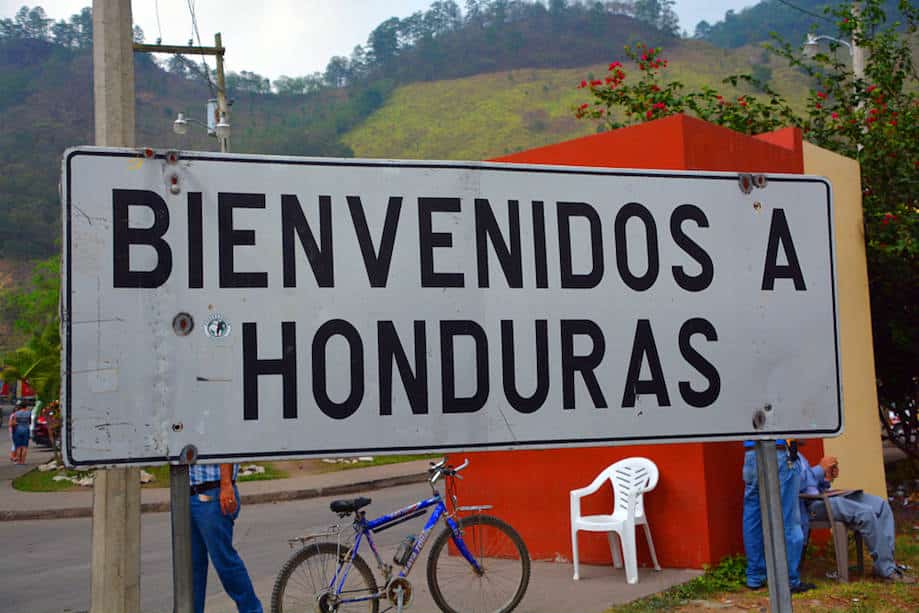
Despite the instability, crossing the borders of Central America is safe for travelers. Photo by mynierd, Shutterstock
As for public safety, just take the basic precautions that we already have in any Brazilian city or worldwide: avoid places and dark if we are alone, do not get into neighborhoods that you do not know very well, do not give a lot of painting with valuables and do not take your eyes off your things or for a moment.
Documents needed to cross borders of Central America by land
The countries of Central America are not part of the agreement that Brazil has with the neighbors of South America, to travel with the identity. Therefore, it is necessary to carry a valid passport to enter all countries in the region. None of them ask for visas for Brazilians, but some may charge entry fees when going through immigration.
These amounts vary from country to country and can be paid in dollars or in local currency (see below). Always always take with you the International Certificate of Vaccination against Yellow Fever and a proof of departure from the country (it can only be a flight booking).
There are no entry or exit fees, but may require passage from the country and proof of sufficient funds to cover the trip. Vaccinated Brazilians must have a certificate of vaccination. Unvaccinated should be vaccinated in the country, free of charge. You also need to fill out a health form. Entrance gives direct to 180 days of stay.
There is no entry fee, but you have to pay a tax of $8 at the time of departure. They require exit passage on immigration and a voucher of at least 10 dollars per day of stay, to cover the expenses of the trip. It is also necessary to fill out a Health Pass and present COVID vaccination certificate. Non-vaccinations must also provide an insurance policy. After passing through immigration, you will have the right to stay for 90 days.
It is necessary to pay a fee of 12 dollars to enter the country and, in some cases, 1 dollar more, of customs inspection. To get out, there’s a $2 fee. It is necessary to present a negative RT-PCR test done up to 96 hours before arrival and passengers can undergo medical examinations. A government health form needs to be completed up to 7 of the before the trip.
Nicaragua is part of a group called CA-4, which also includes the countries Honduras, Guatemala and El Salvador. On immigration, you receive a 90-day permit to stay in the countries of this group (equal to the Schengen Area in Europe).
There is an entry fee of three dollars and a 90-day stay permit between the CA-4 country. Even if you come from other CA-4 countries, the fee needs to be paid. Only travelers from outside the high-risk area to Covid are accepted. It is necessary to present RT-PCR test or a complete vaccination certificate and fill out a government health form.
There is no specific requirement for immigration, just valid passport and proof of yellow fever vaccine. If you come by land, there is no entry fee. At the airport, $10 is charged at the entrance. There are no additional requirements due to Covid.
Officially there are no entrance or exit fees, but on the borders by land there are reports of attempted extortion or coup by the police. It is necessary to present RT-PCR test or a complete vaccination certificate.
A fee of $15 is charged on the way out of the country, plus a tax of $3.75 to help preserve protected areas, in land immigration. Those who leave the country of the plane already pay these taxes embedded in the value of the passage. An RT-PCR test is required to be done up to 96h before arrival. Tourists are required to book and stay in an approved Gold Standard accommodation. A list of approved hotels can be accessed here.
How to cross the border of Panama and Colombia: can you land?
The border between Panama and Colombia is the only one where it is impossible to cross land. Many people, including me, spend hours on the internet trying to find a viable path, so I will already be very direct to save your time: it does not work. The point at which the two countries unite is the only point, from Argentina to Canada, where the Pan-American road is disrupted. The area is covered by a dense forest that – they say there – is dominated by drug traffickers. So you can get the horse out of the rain at once. And since we cannot pass by land, we can only have water and air.
Flying is the fastest and most economical way to cross from Panama to Colombia and vice versa. Copa Air and Avianca offer several daily flights for between $100 and $200 from and to Cartagena, Bogota and other cities in Colombia. This is also the most bland way.
If you have a lot of money left and want to have a more interesting experience, you can make the boat crossing. There are several travel agencies that make the journey, which costs between $400 and 500 and lasts four days, with the right to stop in the paradisiacal archipelago of San Blás and meals included (often prepared with fish caught on the spot).
You can do all this on your own, without hiring agency and negotiating directly with the boats in ports, and it is around R $ 1500 per person, but this is only a recommended option if you want adventure, because it is a complicated process. The blogs Mundo Sem End and Viajes y Cosas Así did it this way and tell how it was.
There is information on the internet about a supposed ferry that makes this crossing in 24 hours. I investigated the matter and found that a company, Ferry Xpress, even offered the service for a brief period, but it has already been discontinued.
How to cross the border of Costa Rica and Panama through the Caribbean or the Pacific
The instructions below are in the Costa Rica – Panama direction, but also work if done in reverse.
- By the Caribbean: You must reach the border town of Sixaola. Departing from Puerto Viejo, take the bus that stops at the main point of Puerto Viejo, next to the Café La Parada and in front of the office where the tickets are bought. The ticket costs 3 dollars and the trip lasts 50 minutes. When you arrive at the Sixaola bus station, get off the bus and look for a small “office” in which you will need to pay the outgoing tax. The place doesn’t look like anything official, it’s just a small little candle, so ask or just follow the other people on your bus who are likely to be doing the same path. With the proof of payment in hand, head towards the bridge, where the immigration office is located. You need to get in line to record your departure from the country.
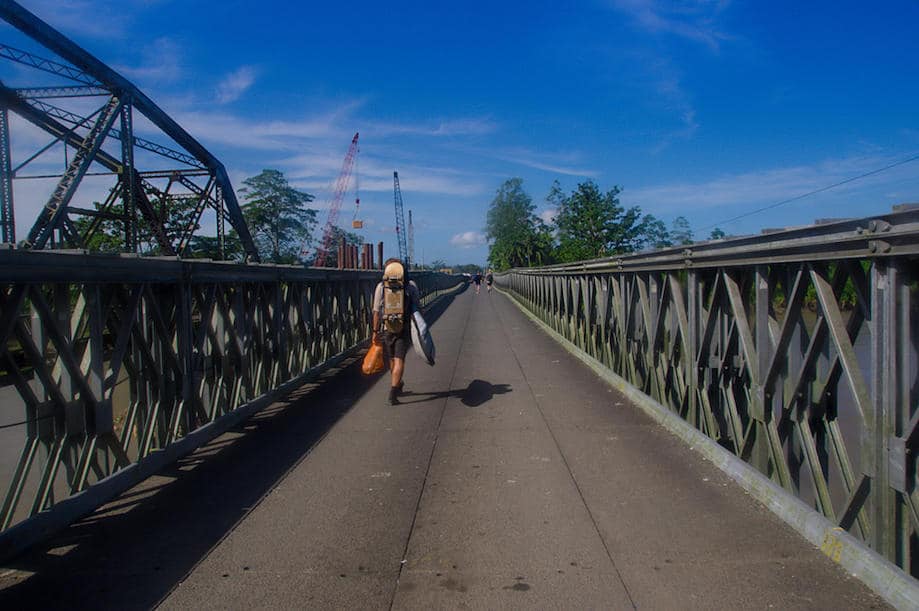
Crossing the bridge that connects Panama to Costa Rica on the Caribbean side is one of the most famous borders in Central America. Photo: photos593 Shutterstock.
Then cross the bridge to enter Panama. On your right side will be the office of the ductana. Please stop there first to fill out the entry form. Then, on the left side of the bridge are the immigration counters. With a stamped passport, take a taxi to the Changinola bus station and from there you can take a bus to Almirante (for those who go to Bocas del Toro) or other destinations in the country.
- By the Pacific: I don’t have such a detailed description of this border, but if you cross the Pacific from Costa Rica, you need to get to Paso Canoas, which is the border with Panama and then take a minibus to David, in Panama. Some lines that descend through Panamericana lead directly to David. So just go down at the border, go through immigration and get back on the bus.
David is a great choice because it is a relatively large city that has many bus lines for the rest of the country. Therefore, if you will skip Bocas del Toro and go directly to Panama City, the best you can do is to go through David, because there are many more buses a day than in Changinola or Admiral. But if you are going down the Pacific and want to cross to the Caribbean to get to Bocas, you should also make this route, going to David first and from there take a van to Admiral.
Nicaragua and Costa Rica
The border town is Penas Blancas, on the Nicaragua side. You can buy direct buses and several companies from San José or Alajuela, in Costa Rica, Managua, León or Granada and even other cities in Nicaragua and vice versa. This makes the crossing much easier, because the employees of the bus company always assist at the time of immigration, indicating where you should go, what the value of the fees and other useful things. And on that border in particular, that’s interesting because it’s all a little confusing.
To start, give good walk between the immigration points of the two countries and you need to do this with the backpacks, because they have to go through the dishana. The bus I was on took us from one point to another, but some companies may ask you to walk and cross the border on foot. Luckily, the border is busy and there are many people in the same situation, as well as buses and trucks, so you can get where you have to go. The people who offer help will charge you for it. If you are leaving Costa Rica, there is an $8 fee.
Border of El Salvador and Honduras
There are several points of border between El Salvador and Honduras. One of the most common among tourists crossing the area is El Poy, because it is the closest to the ruins of Copán, Honduras. If you come from El Salvador, you have to take a bus to El Poy. The trip lasts three hours. From there, just get off the bus and walk to the immigration office. Walk a little more and register entry in Honduras. You have to pay a $3 fee to enter the country.
On the Honduran side there is not much, but you can take a taxi to Ocotepeque and from there go to Santa Rosa de Copán, which is what most people do. I, as I said, jumped the country and went by bus to the Nicaraguan border.
Border of Honduras and Nicaragua
As I left El Salvador on a Tica bus that took me to the border of Honduras, waited for me to cross, picked me up the other side and took me to the border with Nicaragua, repeated the process and, in the end, left me at the Managua bus station, the whole movement of crossing these two countries was very simple. Those who do on their own spend less, but have to change the means of transport a few times more, including some bici-taxi that take from Guasale (Honduras) to the border.
In my case, the only issue here was bureaucratic: the Nicaraguan border was the most annoying one I went through on the trip. You have to pay an entry fee of 12 dollars and they took a long time to release the passport and bags.
If you have information about the missing Central American borders in this text, please leave a comment and help make this guide more complete.

Sign up for our newsletter and stay up to date with exclusive news
that can transform your routine!
Warning: Undefined array key "title" in /home/storelat/public_html/wp-content/plugins/link-whisper-premium/templates/frontend/related-posts.php on line 12
Warning: Undefined array key "title_tag" in /home/storelat/public_html/wp-content/plugins/link-whisper-premium/templates/frontend/related-posts.php on line 13

